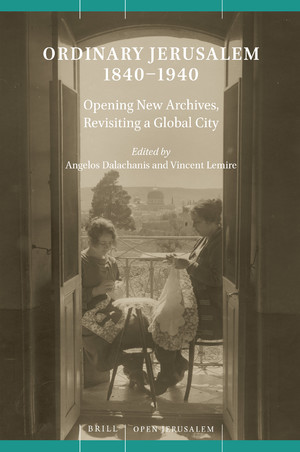
In a recent issue of City (March 20, 2016), Yiftachel and Bonano jointly muse on the uniqueness vs. ordinary nature of Jerusalem. Yiftachel, borrowing from Borges, suggests seeing Jerusalem as Aleph, a template upon which critical new urban theories may be based, and Bonano approaches Jerusalem as a paradigm when he offers, following Agamben, a theory of “whatever urbanism” based on ideas of the city. Jerusalem has surely never been an ordinary city and yet, as this edited volume reminds us, it was always inhabited by ordinary people who sought in their very different and resourceful ways to live their lives within its unique urban setting. Intriguingly titled Ordinary Jerusalem, this voluminous collection, the first fruit of an ERC funded project, includes work by the two editors and thirty-seven scholars from a variety of disciplines and backgrounds who together paint a variegated, original and thought-provoking canvas of 1840-1940 Jerusalem. Two key questions guide the individual chapters as well as the book’s conclusion: Is Jerusalem an ordinary city? And: can we better understand its history through a local or global approach? These questions are taken on separately in each of the chapters, arranged in four sections and premised on that Jerusalem can only be studied by “ordinary” research. The book thus offers a new methodology for reading the city, through unpublished archival materials in different languages scattered throughout the world.
However, bringing the new methodology is but one of the significant contributions of this work. The Open University project is also a historiographical novelty in its choice of non-political timeline. By disregarding the widely accepted geopolitical periodization of Jerusalem’s history into the Ottoman (1517-1918), followed by the Mandate period (1918-1948), the editors deconstruct – or avoid – the typical political strongbox. They thus also enable another important focus of the project: telescoping the city’s residents and a plethora of urban issues through the idea of citadinité, an originally French, primarily post-Marxist, scholarly concept involving “the right to the city.” For Lefebvre, the idea of citadinité extends beyond the privilege of a city’s dwellers to occupy its spaces, conferring upon them the birthright to participate in their urban milieu as oeuvre and ongoing process of construction, destruction and daily negotiating. Framing the city through the idea of citadinité intertwined with an apolitical timeline advances the study of daily Jerusalem life from the bottom up, replacing the hyperbolic top-down depictions tending to obfuscate the earthly nature of the city’s daily life. I find this innovative and refreshing, critical and particularly insightful in creating an effective framework for the volume’s many chapters and lookout points.
The twenty-six chapters of the book are divided into four thematic sections. The first, Opening the Archives, Revealing the City, consists of six chapters showing how Ottoman authorities, foreign powers and outside observers (travelers, most of them Christian religious figures) relied primarily on religious affiliation, referred to as millet, rather than other markers to identify the different groups and individuals dwelling together in the Ottoman Empire. This classification was not only imposed from above, but also upheld by local religious and political leaders, who personally gained from the lingering construction of socio-religious boundaries among the respective communities and other citadines.
The second section, Imperial Allegiances and Local Authorities, through its seven chapters considers various urban institutions: the courts, consulates, patriarchate and so forth, underscoring the growing impact of imperial governing logic on local conduct. The section goes on to highlight the relationship between the locals and the state by detailing an elaborate view of the way imperial institutions, municipalities, court records, police stations and others were instantiated in the local sphere as well as transformed by it. In the six chapters making up the Cultural Networks, Public Knowledge section, the changing character of the city is pitted against the increase in exchanges of different types of knowledge during the latter part of the 19th century. Was Jerusalem becoming an Ottoman city or did the emerging nationalistic conflict between Jews and Arabs hinge upon the city’s predating Ottoman characteristics? This is explored through a variety of sources from Jewish newspapers through Christian printing houses to the photographic collection of a local Muslim Jerusalemite. The fourth section, Sharing the City: Contacts, Claims and Conflicts, concentrates in its seven chapters on different types of ties among Jerusalem’s citadines. The authors rely on archival sources to trace how city locals – and, occasionally, influential figures – interacted and impacted each other. The various narratives lead to the question, posed by Algazi in his preface to this concluding section and by Fishman in the closing chapter of the book, if citadinité can serve as a frame to explore Jerusalem. I, for one, still think it does!
This book is a wonderful addition to the study of Jerusalem of the 19th-20th centuries. The novelty of its content is surpassed only by that of the approach put forth by the editors and contributors. Surely, as Doumani in his preface to the collection’s second section proposes, not all chapters can in equal measure meet the challenge of the Open Jerusalem project. But be that as it may, it has been a long time since I last encountered such a thought-provoking, innovative, well-informed and informative volume. Its importance goes far beyond the field of Jerusalem research; the collection will impact both the methodology and the theory of studying urbanism, urbanity, and urban citizenship.
Nimrod Luz, Kinneret College on the Sea of Galilee
Ordinary Jerusalem 1840-1940: Opening New Archives, Revisiting a Global City, Vol I. , eds. Angelos Dalachanis and Vincent Lemire, (Leiden-Boston: Brill, 2018), pp. 594.
DOI: 10.48248/issn.2037-741X/1816